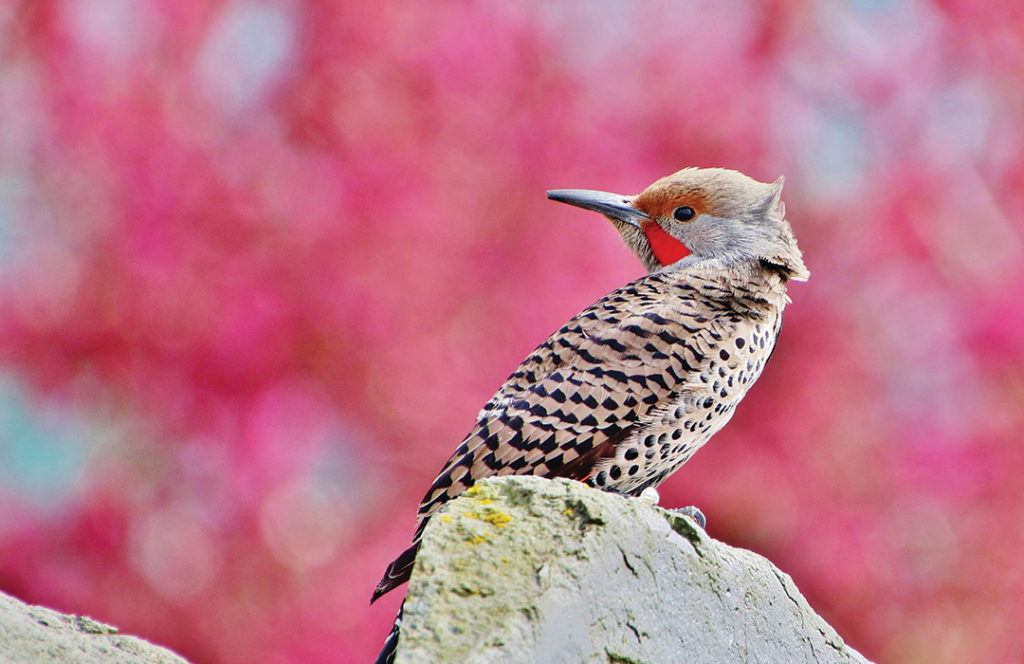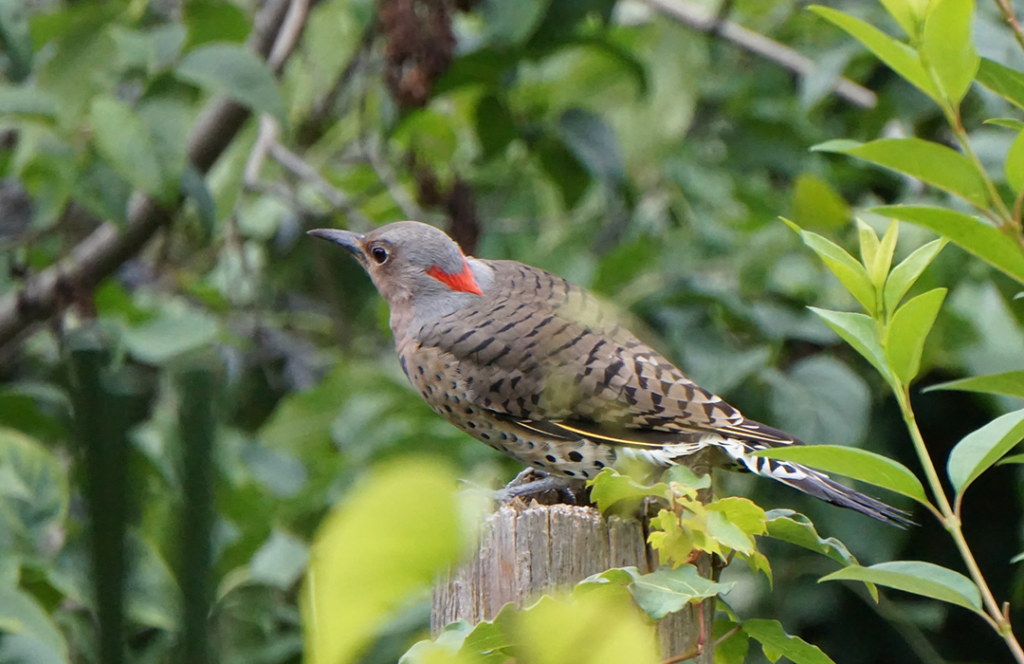March’s Winner is The Northern Flicker!
Meet the Northern Flicker, a loud, flashy, and bold woodpecker that forages mostly on the ground, unlike most woodpeckers (watch your step!). You may also see these colourful birds swooping overhead, streaking the sky with bright red or gold inner wings.
Northern Flickers drum on hard surfaces for communication—not just for dinner. You may indeed hear one of these noisy birds before you see them, calling or rapping their unique, slightly curved beaks on anything from gutters to roofs to metal signs in order to assert their dominance and protect their nesting territory.
Mating season brings another kind of display, as beautiful and brazen males will show off for prospective females by ‘fencing’ with their beaks, pointing them skyward and swinging their heads back and forth while making distinctive ‘wicka wicka wicka’ sounds.
Though relatively common, loss of habitat and habitat degradation, not to mention a lack of nesting sites, mean that Northern Flickers could certainly use our help. Read on to learn more about these fascinating birds and how you can help them succeed in an increasingly human-developed world.
Physical features
Northern Flickers are large birds with black scalloped plumages. They have long beaks and are covered with black spots. The Northern Flicker is one of the few migratory North American woodpeckers. The two forms in which the bird comes in are Yellow-shafted Flickers and Red-shafted flickers. Yellow-shafted flickers are generally found in the Northeast whereas Red-shafted Flickers are mostly present in the West. However, both tend to migrate to the South during the winter months with a few remaining in the North.

The brown woodpeckers are typically found singly or in pairs. Nonetheless, they gather in large loose groups during the winter or migration. All woodpeckers benefit from the ability to extract and spear insects and other living things in wood. However, the Flicker’s tongue is different as it is extra-long, extending up to two inches past the tip of the beak. Typically, both males and females have red nape crescents making it hard to distinguish the two from a distance.
Fun facts
- The two forms of Flickers were once considered to be separate species. They are now recognized as one.
- The oldest known Yellow-shafted Northern Flicker is a male of 9 years old.
- The oldest known Red-shafted Northern Flicker is an 8-year-old male.
- Unlike other woodpeckers, Flickers are very commonly found on the ground, allowing them to use their long bill to probe into anthills and soils.
Habitat and nesting
These woodpeckers tend to live in open forests, groves, woodlots, and semi-open countrysides. They can also be found in wet habitats including swamps and streamside woods. Nevertheless, it is definitely not uncommon to find them in towns and cities due to their wide habitat range. In fact, Northern Flickers have greatly suffered from habitat loss, especially caused by a general lack of nesting sites due to anthropogenic factors. Another factor causing habitat loss and degradation for Northern Flickers is competition for nesting sites from other cavity-nesting bird species. Spring heatwaves and wildfires due to climate change can also become threats to habitat and nesting sites of Northern Flickers.

Nests are usually placed 6 to 15 feet off the ground but have been raised up to 100 feet above the ground. Northern Flickers tend to nest holes in diseased or dead trees due to their ability to be easily excavated. When it comes to nest excavation, although both sexes are involved, males usually do most of the labour. Male Flickers are in charge of establishing and defending their nesting territories by continuously aggressively drumming on resonant surfaces such as wood. When it comes to parenting, both parents are responsible for feeding the young and continue to do so until their offspring becomes independent enough to gather their own food. Feeding is done by regurgitation. Young woodpeckers tend to leave the nest about 4 weeks after hatching.
Attracting a Northern Flicker
There are ways you can help Northern Flickers starting in your own backyard. As previously mentioned, Northern Flickers can be commonly found in urban areas. Therefore, they can easily be found in your local backyards and birdbaths. Nest boxes can be used to attract a breeding pair in your backyard prior to breeding season. These are ways to aid birds that struggle from habitat loss due to shortages in places to nest. In fact, birdhouses do not have to be restricted to backyards and can also be placed in schoolyards, farms, parks, orchards, and many other places.
Cities across Canada are doing the work to make their buildings bird friendly. Find out more about how you can make your city a Bird Friendly City.



